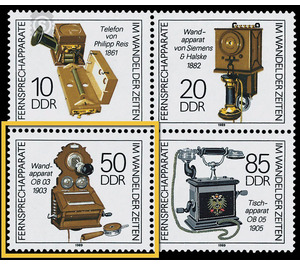Telephone sets in the changing times - Germany / German Democratic Republic 1989 - 50 Pfennig
Theme: Communication & Media
| Country | Germany / German Democratic Republic |
| Issue Date | 1989 |
| Face Value | 50.00 |
| Color | brown grey |
| Perforation | K 14 |
| Printing Type | offset |
| Stamp Type | Postage stamp |
| Item Type | Stamp |
| Chronological Issue Number | 2970 |
| Chronological Chapter | GER-DDR |
| SID | 529582 |
| In 18 Wishlists | |
Telephone sets in the changing times With the depictions of telephone sets over the ages, the Ministry of Posts and Telecommunications of the German Democratic Republic is issuing four multicolored special postage stamps, one after the other, in unison. Special cancellations from February 7 to April 6, 1989 Telephone sets through the ages This series of stamps introduces telephone sets from the first half century of their development. In addition to the phone of Philipp Reis (1834-1874), which did not come to practical use, three of the German Reichspost used local battery devices (power supply by batteries at the subscriber) are shown. The wall-mounted OB 03 from 1903, pictured on the 50-pfennig value, was equipped with a coal-grain microphone capsule housed on an adjustable microphone support with speech funnel, facilitating the use of the apparatus by persons of various sizes. The desk-shaped walnut housing with two rails for attaching a paper block to the lid made writing possible while standing. Connection terminals and hook switches were outside on the left side. To better perceive the call, the bell cups from the alarm were mounted outside the case. The handset was made smaller and lighter by the ring magnet used and much more handy with a wooden handle. Another innovation was the introduction of the crank inductor to generate the Rufwechselstroms. He saved the maintenance-intensive and costly wake-up batteries at the subscriber terminals. The crank protruded right out of the case. The telephone sets presented on this stamp series as well as other, from these and later stages of development can be visited in the Postal Museum of the GDR.


